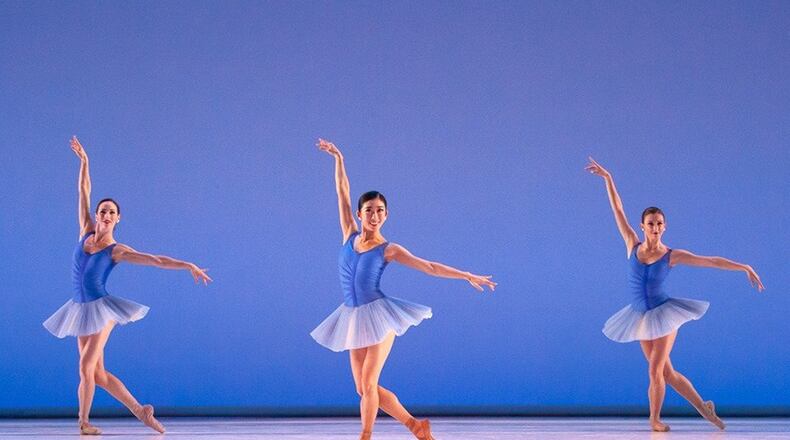To close its 2018-19 season, the Atlanta Ballet presented a pleasant, if uneven, program of three works, ending with a world premiere created on the company by star choreographer Liam Scarlett, artist-in-residence at London’s Royal Ballet.
Movement and costumes for the opening work, Kiyon Ross’ “Sum Stravinsky,” had an old-fashioned balletic daintiness, an intentional subversion of the expectation for modern grit and gutsiness that the name Stravinsky evokes. The strategy is an inventive one, but working in that vein throughout, the piece often developed a sort of “Disney’s Fantasia” kitschiness.
The dance was originally created for a program of all Stravinsky works, where it would clearly sit more successfully, poking out as a cheeky, unexpected, uncharacteristic surprise, rather than here on a program of mixed works with music by other composers where it seemed somewhat overly twee and quaint standing on its own. Solos and duets, of which there were many in the rapidly moving work, fared better than the several ensemble segments, which lacked the synchronous precision the choreography required. Still, the work was charming overall, and the music was lovely (even if the piece “Dumbarton Oaks” catches Stravinsky in a rare sedate, sunny mood). And it was impossible not to be won over by the gorgeous ending, a final frozen tableau that capped the work perfectly with a winning touch of wry humor. From the response on opening night, the landing had clearly stuck, so to speak, and overall, the audience at the Cobb Energy Performing Arts Centre seemed to have been better pleased by the entire work than I’d been.
The notion of split realities, of alternate possibilities and paths in life — mentioned in a brief filmed interview with choreographer Gemma Bond which screened before her work — was given lovely expression by a cast of six dancers in her piece “Denouement,” placed second on the program. Strengths seemed more evenly dispersed across a compelling cast of three male and three female dancers here than in Ross’ piece, where the men often seemed to lag behind the women in executing the movement. Moreover, Bond achieved a lovely sense of variation and detail, beautifully echoing the variation and detail in the music of Benjamin Britten’s meditative Sonata in C, Op. 65, performed live by musicians on stage. Especially inventive were the shifting arrangements of the dancers: beginning with strangely replicating pairs of men and women moving identically, things slowly shifted so one woman was on stage with three men then one male dancer performed with the three women, always in evocative and dramatic arrangements and movements.
The dance also melded beautifully with the set, consisting of several enormous, monolithic scrim flats. In a simple but stunning effect, the dancers stood behind the set pieces and looked out, ghostlike, from behind the flats, which became semi-transparent with light.
Star choreographer Liam Scarlett’s long-awaited world premiere, “Catch,” set to the music of Philip Glass’ famous Violin Concerto No. 1 closed the program. Dancers connected deeply to the appealing score, a fact that was especially apparent in the solos and duets, and lighting designer David Finn created some lovely moments with colored lighting and backdrops. Even when the dancers were lit in a straightforward way, bodies had a wonderful sense of dimensionality and depth.
Surprisingly, some of the work’s most exciting touches didn’t look at all like ballet, or even like “dance” exactly. Dancers often held out a single hand, moving it as if casually tossing an object into the air and then catching it or bouncing it off the floor. The pattern of this simple move became deliciously trippy, strangely workmanlike or clerical, especially when performed synchronously by the entire ensemble, or when the tossing and catching movement itself slowly shifted to become more abstract, less directly referential.
In spite of its many strengths, the shape of the mixed program felt strange, beginning with the weakest work and ending with the strongest. The strategies and abstractions of the second two pieces ran too parallel for the works to sit well together on a mixed program; viewers long to see markedly different styles and approaches. The crowning work came too late in the evening, and the mind and eye had started to get a little full by the time the best dish was placed on the table. It's hard to beat the star presence of a great choreographer like Liam Scarlett, but in the end, I recall being more pleased overall with the mixed program recently presented in the nicely intimate setting of the new City Springs Theatre or the ballet's dreamlike, fairy-tale production of the story ballet classic "La Sylphide."
About the Author
Keep Reading
The Latest
Featured




